FEATURE ARTICLE - 100 Years of change in Australian Industry
NOTES
ABOUT THIS PUBLICATION
This publication provides detailed national accounts estimates for the years 1995-96 to 2003-04.
FEATURE ARTICLE
A feature article has been included in this issue entitled '100 years of change in Australian Industry.' It starts on page 12.
REVISIONS IN THIS ISSUE
The estimates in this issue incorporate new and revised estimates from the annual supply and use tables for 2000-01, 2001-02 and 2002-03 and updated data from other sources which normally become available by this time each year. Of particular note, expenditure on dwelling rent has been revised downwards due to the introduction of new benchmark data from the 2001 Population Census. A more detailed discussion of the revisions appears in the Analysis of results section below.
CHANGES IN THIS ISSUE
Changes have been made to tables which bring this annual publication more in line with the quarterly Australian National Accounts: National Income, Expenditure and Product (cat. no. 5206.0). The changes consist of some new series and a re-ordering and re-labelling of others. The tables affected are:
- Tables 2 to 8, Expenditure on GDP. These now include a split for general government final consumption expenditure and public gross fixed capital formation, a split of intangible fixed assets and a reordering of private gross fixed capital formation. This ordering has also been applied in the capital account tables and capital stock tables.
- Table 5, Expenditure on GDP, and table 12, Income from GDP, replace former tables 8 and 9, Gross domestic product account.
- Table 26 provides selected analytical series, including average compensation of employees and gross entrepreneurial income which were previously shown as memorandum items in the income tables.
- Table 54, External accounts, replaces former tables 53 and 54.
CHANGES IN NEXT ISSUE
The annual estimates presented in the 2004-05 issue will reflect the impact of an important upgrade to the way the ABS compiles its economic statistics. A more detailed explanation appears in the Analysis of results section.
DATA VALUES AND ROUNDING
All values, unless otherwise indicated, are shown in Australian dollars rounded to the nearest million. Values in billions of Australian dollars used in some tables refer to thousand of millions of Australian dollars. Where figures have been rounded, discrepancies may occur between the sums of the component items and totals.
NEXT ISSUE
The next expected release date of this publication is November 2005.
INQUIRIES
For further information contact Michael Anderson on Canberra (02) 6252 6713 for income & consumption estimates, and Patricia Mahony on Canberra (02) 6252 6711 for investment, trade & industry estimates.
ANALYSIS OF RESULTS
GDP GROWTH IN 2003-04
The chain volume measure of gross domestic product increased by 3.8% in 2003-04. The 2003-04 result is an improvement on the 2002-03 growth of 3.2% which was affected by the drought impacting directly on agricultural production and exports of rural goods.
Key chain volume movements in expenditure on GDP in 2003-04 were:
- continued strength of household final consumption expenditure (up 5.6%) driven by growth in purchase of motor vehicles (up 9.7%), furnishings and household equipment (up 9.8%), clothing and footwear (up 6.8%) and health (up 6.4%)
- strong growth (5.7%) in final consumption expenditure on defence
- continued growth in private capital formation with investment in new machinery and equipment up 7.2%, new building up 9.1%, new engineering construction up 13.8% and dwellings up 7.4%. While all these movements are lower than in 2002-03, all components are at record levels
- a rise of 1.5% in exports of goods and services, following a 0.6% fall in 2002-03. Exports of goods rose 1.2%, mainly due to an increase in exports of rural goods (up 4.1%), with cereals up 36%. Exports of services rose 2.7%, driven by the impact of the Rugby World Cup and a rebound in international travel following the SARS epidemic
- growth of 12.4% in imports of goods and services. Imports of goods rose 11.6% with strong imports of consumption goods (up 13.6%) and capital goods (up 19.3%, mainly due to increased imports of ADP and telecommunications equipment). Imports of services rose 15.8%, reflecting strong growth in international travel.
From an industry perspective, most service industries, particularly Wholesale and Retail trade, Accommodation, cafes and restaurants and Transport and storage, showed solid growth in industry chain volume value added in 2003-04. Other industries that showed notable movements in 2003-04 were:
- Agriculture, forestry and fishing (up 28.4%) due to the rebound in agricultural production from the 2002-03 drought
- Mining (excluding services to mining) down 3.1%, its third consecutive annual decline
- Construction up 6.3%, after strong rises of 16.2% and 11.9% in 2002-03 and 2001-02 respectively.
GDP in current prices grew 7.3%. For the income components, there was growth in compensation of employees of 5.6%, growth in the gross operating surplus (GOS) for non-financial corporations of 11.6%, growth in the GOS for financial corporations of 8.8% and a rise in gross mixed income of 8.5%. This last result is closely connected with the rebound from the drought. Agricultural income, a major component of total gross mixed income, rose 61.4% in 2003-04.
Volume growth in GDP over the past four years has been revised following the incorporation of new annual supply and use table benchmarks. In comparison to the annual growth rates published in June quarter 2004, growth in 2000-01 has been revised from 2.0% to 2.1%, growth in 2001-02 is unchanged at 3.9%, growth in 2002-03 has been revised from 3.1% to 3.2% and growth in 2003-04 has been revised from 3.6% to 3.8%. A discussion of the revisions is presented on page 10.
PRODUCTIVITY - MARKET SECTOR
The index of market sector multifactor productivity (MFP) increased in 2003-04 by 2.3%, reflecting a 4.7% increase in gross value added for the market sector against an increase of 2.3% in total labour and capital inputs. Hours worked increased by 1.3% in 2003-04, resulting in labour productivity growth of 3.4% in 2003-04. Capital services continued to grow in 2003-04, recording a strong growth rate of 3.6%. The increase in capital services was less than the increase in gross value added resulting in a rise of 1.0% in capital productivity in 2003-04. This reverses the trend of recent years. The capital-labour ratio increased by 2.3% in 2003-04, reflecting stronger growth in capital relative to labour.
MFP based on quality-adjusted hours worked for 2003-04 increased by 2.2% from 2002-03, a slightly smaller increase compared with MFP based on unadjusted hours worked. This indicates that changes in labour composition (experience and educational attainment) had a positive impact on labour input over the period. The quality adjusted hours worked series and the MFP estimates based on it are experimental.
During the current MFP growth cycle (1998-99 onwards) MFP has grown annually, on average, by 1.0% - slightly lower than the long term average between 1964-65 to 2003-04 of 1.2%. The average annual MFP growth rate of 1.0% over the current cycle reflects an average rate of growth of 2.3% in labour productivity and -0.8% in capital productivity.
GDP PER CAPITA
For some analytical purposes it is important to allow for the impact of population growth on movements in GDP. Reflecting growth in the population, annual growth in GDP per capita has been about 1.0 to 1.8 percentage points lower than that for GDP since 1972-73, and was negative in 1974-75, 1977-78, 1982-83,1990-91 and 1991-92. In 2003-04 GDP per capita increased by 2.5%.
GDP and GDP per Capita
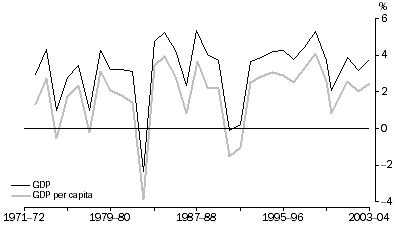
REAL NET NATIONAL DISPOSABLE INCOME
A broader measure of changes in national economic well-being is real net national disposable income (RNNDI). It adjusts the chain volume measure of GDP for the terms of trade effect, real net incomes from overseas and consumption of fixed capital. The graph below provides a comparison of annual movements in GDP in chain volume terms and real net national disposable income. In 2003-04, RNNDI (up 5.5%) has grown more strongly than GDP (up 3.8%) reflecting very strong growth in the terms of trade, offset to some extent by growth in real net incomes payable to the rest of the world.
GDP and RNNDI
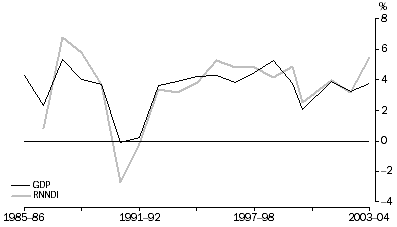
WAGES SHARE OF TOTAL FACTOR INCOME AT CURRENT PRICES
The highest recorded value of the wages share of total factor income was 61.5% in 1974-75. The wages share has recovered somewhat from its low value of 52.8% in 1988-89, but at 53.1% it currently remains below the levels achieved during the 1970s and most of the 1980s. The wages share has remained relatively stable during the 1990s, at levels similar to those during the 1960s.
Wages Share of Total Factor Income
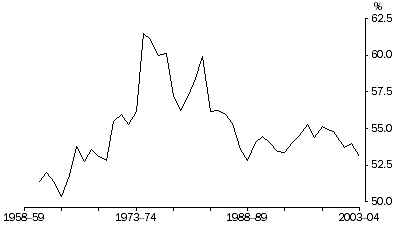
PROFITS SHARE OF TOTAL FACTOR INCOME AT CURRENT PRICES
The profits share (based on GOS for financial and non-financial corporations) of total factor income of 26.7% in 2003-04 is the highest share recorded since 1959-60. The profit shares recorded since the early 1990s are at a distinctly higher level than those at any time since 1959-60. This profit share measure should not be interpreted as a direct measure of 'profitability' for which it is necessary to relate profits to the level of capital assets employed.
Profits Share of Total Factor Income
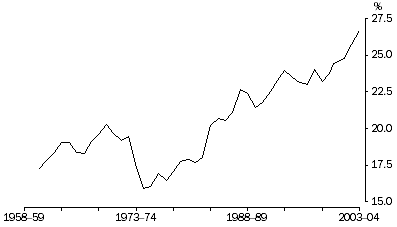
SECTORAL NET SAVING AT CURRENT PRICES
Household net saving as a percentage of GDP generally increased between 1959-60 and 1974-75, but has fallen subsequently from a high of 9.8% in 1974-75 to -1.9% (-$15.2 billion) in 2003-04. An analysis of the declining trend in household saving might also consider changes in the real values of household sector assets, estimates of which are presented in table 48.
Net Saving, By Sector - relative to GDP
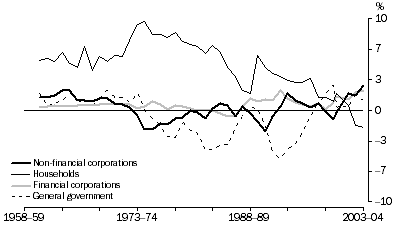
Net saving for non-financial corporations has fluctuated over the period from 1959-60 to 2002-03. In 2003-04 it represented 2.7% of GDP ($22.1 billion). General government net saving was negative from 1975-76 to 1996-97 (except for 1988-89 and 1989-90). In 2003-04 it was 1.0% of GDP ($8.5 billion). Net saving of financial corporations was negative from 1981-82 to 1986-87, the only period for which this sector has recorded negative net saving. In 2003-04, net saving of financial corporations was 2.2% of GDP ($17.8 billion).
Overall, national net saving was positive in 2003-04 at $33.2 billion or 4.1% of GDP.
INVESTMENT AT CURRENT PRICES
As a proportion of GDP, investment (total gross fixed capital formation) by non-financial corporations generally fell during the 1970s and then rose to a peak of 13.1% in 1981-82. It has subsequently been above 10% except for the years 1991-92 to 1993-94. In 2003-04 investment by non-financial corporations was 10.7% of GDP. Household investment as a proportion of GDP declined steadily between 1959-60 and 1973-74 but has since remained steady at around 9% of GDP. In 2003-04 the ratio to GDP was 10.7%. General government investment as a proportion of GDP peaked at 4.6% in 1975-76 and it has generally fallen since then. It was 2.3% of GDP in 2003-04. The highest ever level of financial corporations investment, expressed as a proportion of GDP, was recorded in both 1988-89 and 1989-90 (1.9%). It has generally fallen since and was 0.8% of GDP in 2003-04.
Investment, By Sector - relative to GDP
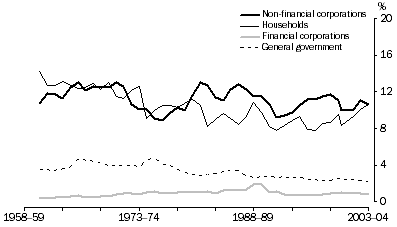
SECTORAL NET LENDING AT CURRENT PRICES
If a sector's gross saving and net capital transfers received exceed its level of investment in any period, that sector will have positive net lending to other sectors. Conversely, if a sector's investment expenditure exceeds its gross saving and net capital transfers received, then that sector will need to borrow from other sectors, i.e. its net lending will be negative.
The household sector was a lender to the other sectors in the economy for all years up to 1993-94. Since then it has been a net borrower from other sectors except for 1995-96 and 1996-97. As a proportion of GDP, borrowing by households was 6.3% in 2003-04. Borrowing by non-financial corporations has fluctuated significantly over the period from 1959-60 to 2002-03 and represented 1.4% of GDP in 2003-04. General government was a net borrower for all years from 1974-75 to 1996-97. After recording a record level of borrowing as a proportion of GDP in 1992-93 (6.4%), general government borrowing declined and from 1997-98 to 1999-00 this sector was a net lender to other sectors. In 2000-01 and 2001-02 general government was a net borrower before returning to being a net lender in 2002-03 and 2003-04, representing 1.0% and 0.4% of GDP respectively. After being a net borrower throughout the 1980's, the financial corporations sector returned to being a net lender in 1990-91 and has remained so in all years since except for 1998-99. In 2003-04 financial corporations net lending represented 2.0% of GDP.
Net Lending, By Sector - relative to GDP
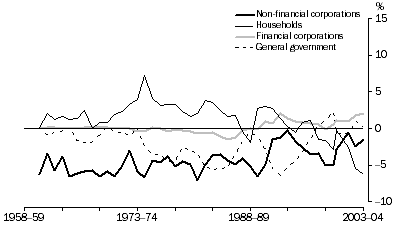
In aggregate, the four domestic sectors have been a net borrower in all years from 1959-60 except for 1972-73. The ratio of net borrowing from overseas to GDP in 2003-04 was 5.6%, the highest ratio since 1994-95 when it was 5.9%.
Net Lending to Overseas, relative to GDP
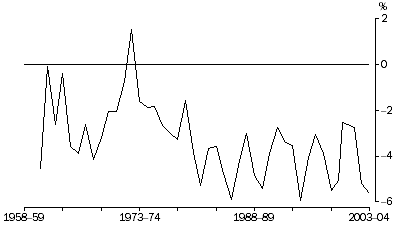
INTERNATIONAL TRADE
The growing importance of international trade to the Australian economy is illustrated by the following graph which shows the ratios of exports and imports of goods and services to GDP in current prices for the financial years 1959-60 to 2003-04. In 2003-04 the imports ratio was 20.6% and the exports ratio, which has fallen for the past three years, was 17.6%.
Exports and Imports, relative to GDP
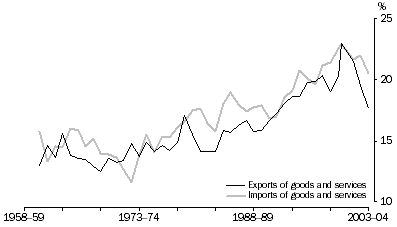
NATIONAL BALANCE SHEET
Net worth is defined as the difference between total assets and total liabilities (including shares). Australia's net worth at the end of June 2004 was estimated to be $3,876.7 billion, an increase of $473.8 billion (13.9%) since 30 June 2003. Of the increase, $31.0 billion was due to transactions (both capital and financial), and $442.8 billion was due to revaluations and other flows (including discoveries of subsoil assets). The average annual rise in net worth over the period 30 June 1992 to 30 June 2004 was 7.5%. The graph below shows that the net worth series has exhibited the strongest growth in the years since 1996-97 during which annual rates of at least 6.0% have been achieved.
Percentage change in total net worth - as at 30 June
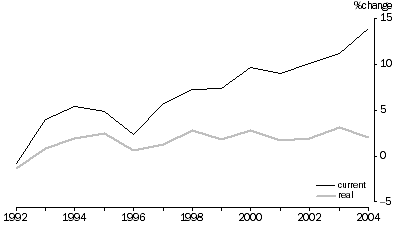
Total produced assets at 30 June 2004 were estimated at $2,230.4 billion, an increase of 6.0% from the level at the end of June 2003. The estimated value of produced assets rose at an average annual rate of 5.0% between 30 June 1992 and 30 June 2004 and consistently accounted for over 55% of net worth. At 30 June 2004, dwellings, non-dwelling construction, and machinery and equipment represented 92% of total produced assets.
The value of non-produced assets at 30 June 2004 was estimated at $2,147.4 billion, a rise of 22.8% from the level at the end of June 2003. The average annual rise between 30 June 1992 and 30 June 2004 was 11.5%. Over this period, the share of land fell from around 90% to 82% of total non-produced assets.
The difference between Australia's assets and liabilities with the rest of the world represents the net international investment position. Australia's net liabilities stood at $501.1 billion at 30 June 2004, a rise of 11.2% on the position at the end of June 2003. The contribution of net liabilities to net worth increased steadily from 12.7% at 30 June 1992 to a peak of 14.4% at 30 June 1996. At 30 June 2004 the contribution to net worth stood at 12.9%.
Australia's real net worth increased by 2.0% over the year ended 30 June 2004 compared with the average annual growth over the period 30 June 1992 to 30 June 2004 of 1.9%. In the latest year the real value of non-financial assets grew by 2.9%, the real value of financial assets grew by 16.5% and the real value of liabilities grew by 13.0%.
REVISIONS TO GDP
Revisions have been made to a range of national accounts estimates. They have resulted from the availability of more up to date source data and the incorporation of new supply and use benchmarks for 2000-01, 2001-02 and 2002-03. The balancing of the supply and use tables ensures that the three measures of GDP are consistent but inevitably some components are revised as a result of the balancing process. Compared with the estimates released in the June quarter 2004 quarterly national accounts publication, the level of GDP in current prices was revised down in 2000-01 (-$2.7 billion) and in 2001-02 (-$1.1 billion) and upwards in 2002-03 (+$2.0 billion) and in 2003-04 (+$2.3 billion). These revisions impacted on growth rates to a small extent. In chain volume terms GDP was revised upwards in 2000-01 (+0.1%), 2002-03 (+0.1%) and in 2003-04 (+0.2%) and was unchanged in 2001-02.
A number of components of GDP were revised consistent with these aggregate movements
- On the income side of GDP the gross operating surplus of private non-financial corporations and gross mixed income of unincorporated enterprises were revised reflecting both the incorporation of new source data from the Australian Taxation Office and the effect of supply and use table balancing. The gross operating surplus of financial corporations was revised reflecting revisions to financial intermediation services indirectly measured (using updated interest flow data), and to a smaller extent, revisions to the insurance service charge. GOS on dwellings owned by persons was revised downwards following the introduction of new benchmark data for dwelling rent from the 2001 Population Census.
- On the expenditure side of GDP there were revisions to household final consumption expenditure reflecting the incorporation of new benchmark data for dwelling rent and the effect of supply and use table balancing.
Aside from revisions made to GDP and its components, a range of series through the income accounts, capital accounts, financial accounts and balance sheets have been revised due to the availability of updated source data and methodological improvements.
Of particular note is the allocation of computer software GFCF to industry which has been improved since the previous issue. For private GFCF, software is now allocated using information about the distribution of new computer equipment to industry. For public GFCF, the allocation of computer software to industry is based on a new methodology. These changes impact on the industry estimates of GFCF, capital stock and consumption of fixed capital.
CHANGES IN NEXT ISSUE
The annual estimates presented in the 2004-05 issue will reflect the impact of an important upgrade to the way the ABS compiles its economic statistics. In particular the register of businesses that provides the frame for the various sources used in compiling the national accounts has been changed to align more closely with information about businesses as reflected on the Australian Business Register (ABR). A detailed explanation about this change was provided in Information Paper: Improvements in ABS Economic Statistics [Arising from The New Tax System] (cat. no. 1372.0) released by the ABS in May 2002. This change will require that the full national accounting time series be revised to reflect the changed basis. It is expected that the most noticeable impact will be in respect of the industry composition of GDP.
At the same time as incorporating these new data, the ABS plans to introduce changes to other series to reflect updated data or methodological improvements. These changes may impact on the full timespan.
More detailed explanations about major changes to the annual estimates will be described in a feature article in the March quarter 2005 issue of Australian National Accounts: National Income, Expenditure and Product (cat. no. 5206.0).
 Print Page
Print Page
 Print All
Print All